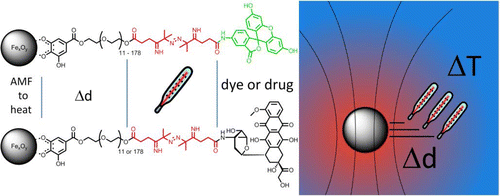 A cooperation between the group of Teresa Pellegrino at Italian Institute of Technology and Miguel angel Garcia form the Institute of Ceramic and Glass, CSIC, just published a paper in Nano Letters presenting a method to probe and control the temperature around a magnetic nanoparticle with sub-nanometer resolution.
A cooperation between the group of Teresa Pellegrino at Italian Institute of Technology and Miguel angel Garcia form the Institute of Ceramic and Glass, CSIC, just published a paper in Nano Letters presenting a method to probe and control the temperature around a magnetic nanoparticle with sub-nanometer resolution.
The work has been developed within the frame of the European FP7 project MAGNIFYCO focused on the use of magnetic nanoparticles for the diagnosis and therapy of tumors. Upon magnetic AC fields, the magnetic nanoparticles become heated and dissipate heat to the surrounding medium increasing locally the temperature. This increase of temperature can be used to eliminate cells selectively and release drugs in a controlled way.
While this is hot topic, the determination of the distribution of temperatures around the magnetic nanoparticles upon heating was still an open issue. The authors developed a method based on the use of a thermo-sensitive molecule, namely, azobis[N-(2-carboxyethyl)-2-methylpropionamidine] that decomposes progressively above room temperature. This thermo-sensible molecule is placed at a fixed distance of the iron oxide nanoparticle using a polymer (PEG) as spacer, and linked to a fluorescent molecule (fluoresceinamine). Upon heating, the thermo-sensible molecule decomposes releasing the fluorescein molecule. Measuring the photoluminescence intensity of the released fluoresceinamine, it is possible to determine the temperature achieved at the thermo-sensible molecule. With this method, it was possible to determine the distribution of temperatures around the magnetic iron oxide nanoparticle with a resolution below the nanometer, not previously achieved in this type of measurements.
Those results confirmed that at this scale the heat transfer does not follow the physical laws valid for macroscopic materials. As a consequence the heating results much more local than expected.
he thermo-sensible molecule can be also used for a controlled druge release. Substituting the fluorescent molecule by a drug, it can be released in a controlled way in order to increase the effectiveness and to reduce secondary effects.
“Subnanometer Local Temperature Probing and Remotely Controlled Drug Release Based on Azo-Functionalized Iron Oxide Nanoparticles” Andreas Riedinger, Pablo Guardia, Alberto Curcio, Miguel A. Garcia, Roberto Cingolani, Liberato Manna and Teresa Pellegrino.
http://pubs.acs.org/doi/abs/10.1021/nl400188q
